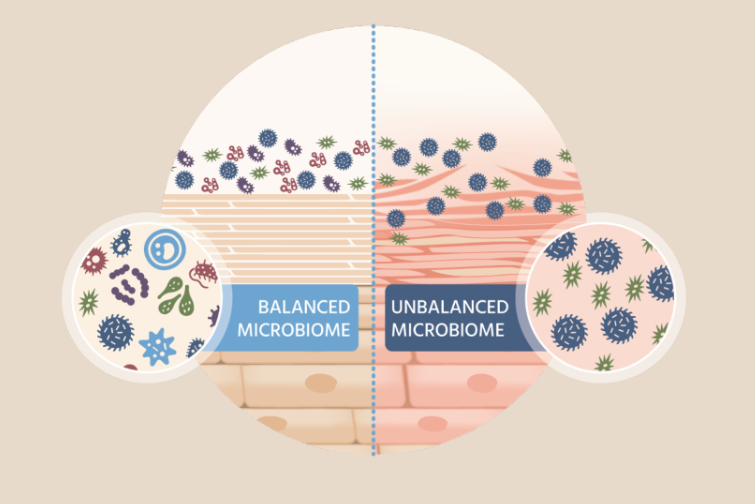The human skin serves as a crucial protective barrier, home to billions of microorganisms including bacteria, fungi, viruses, and archaea, collectively known as the skin microbiome. This complex microbial community plays a vital role in maintaining inflammatory homeostasis and regulating immune responses. However, in various dermatological conditions such as acne, atopic dermatitis, psoriasis, and rosacea, this delicate balance is disrupted, leading to a state of dysbiosis.
Recent advancements in genomic sequencing technologies, particularly shotgun whole-genome sequencing (WGS) compared to 16S ribosomal RNA (rRNA) sequencing, have significantly improved the accuracy of species detection and enhanced our understanding of the skin microbiome’s role in health and disease. This deeper insight has led to the consideration of the microbiome itself as a potential target for therapeutic interventions in dermatological conditions. Traditional treatments, such as antibiotics, often come with highly toxic side effects and contribute to the urgent public health issue of antibiotic resistance. Consequently, exploring alternative, safer, and potentially more cost-effective solutions like prebiotic and probiotic treatments has gained increasing interest as a way to restore the skin microbiome and improve patient outcomes. This review aimed to summarize the most up-to-date information on skin microbiome shifts in various dermatological diseases, building upon previous research to offer a more comprehensive understanding of these complex interactions.
Key Findings
• Ubiquitous Presence of Staphylococcus aureus: Staphylococcus aureus was reported unanimously in all skin conditions examined, consistently found to be elevated in diseased skin.
• Decreased Microbiome Diversity: Most studies, with the exception of those investigating acne vulgaris, demonstrated a decreased microbiome diversity in diseased skin compared to healthy or nonlesional areas.
• Increased Pro-inflammatory Strains: There was a general shift towards an increased proportion of pro-inflammatory bacterial and fungal strains in affected skin.
• Condition-Specific Shifts:
◦ Acne Vulgaris: Showed increased Staphylococcus and Firmicutes in lesional skin, decreased Proteobacteria, with inconclusive findings on Shannon alpha diversity.
◦ Atopic Dermatitis (AD): Characterized by a significant reduction in Shannon diversity index and increased Staphylococcus aureus, with its abundance correlating with disease severity. Decreased Cutibacterium, Lactobacillus, Corynebacterium, and Propionibacterium were also noted.
◦ Diaper Dermatitis (DD): Exhibited significantly increased Shannon diversity and Chao index, alongside increased Proteobacteria, Enterococcus, Erwinia, Pseudomonas, Rhodococcus, Acinetobacter, and Ruminococcus, while Clostridium and Actinomyces decreased.
◦ Lamellar Ichthyosis (LI): Featured increased methicillin-resistant Staphylococcus aureus (MRSA), Fusobacterium, Gram-negative rods, and fungal populations (primarily Candida), with MRSA exclusively observed in LI patients.
◦ Psoriasis: Demonstrated an increased Firmicute phylum and decreased Proteobacteria phylum, without significant differences in Shannon diversity or richness.
◦ Seborrheic Dermatitis (SD): Identified increases in several fungal (Malassezia, Alternaria, Nagnishia, Hanseniaspora, Cladophialophora) and bacterial (Staphylococcus, Blautia, Bifidobacterium, Xylanimicrobium, Fusobacterium, Lysobacter) genera, coupled with a significant decrease in Shannon diversity.
The future implications of this study are substantial, particularly in shifting away from traditional antibiotic use. Prebiotic and probiotic treatments emerge as promising, potentially safer, and more cost-effective alternatives for restoring the skin microbiome and improving patient outcomes. However, further research is essential to fully understand the intricate microbiome changes and to confirm the efficacy and viability of probiotic treatments, optimize their formulations, and define clear clinical indications. Future work should also explore postbiotic and synbiotic approaches, which offer advantages like improved stability and reduced infection risk. Innovative delivery strategies, such as combining low-frequency ultrasound with microbiome-derived metabolites, could enhance cutaneous delivery and engage cellular signaling pathways. Furthermore, the integration of advanced technologies like deep convolutional neural networks and Cross-Modal Causal Representation Learning frameworks can refine microbiome analysis and reduce bias. Ultimately, the application of emerging spatial and single-cell technologies will be crucial to map microbe-host interactions in situ, accelerating the development of precise, mechanism-guided, and personalized microbiome-based dermatologic therapies.
Link to the study: https://www.mdpi.com/2077-0383/14/17/6137

